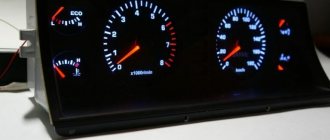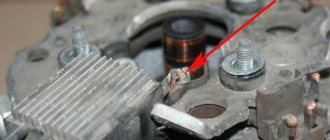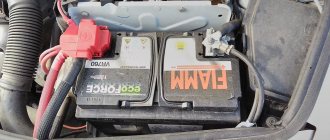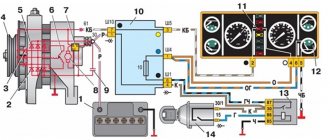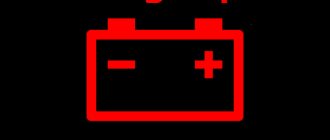In cases where the battery stops receiving charging, the charge indicator light on the VAZ 2106 instrument panel lights up.
| External view of the instrument panel of a VAZ 2106 car. The numbers indicate: 19 – external lighting switch; 18 – rear window heating switch; 17 – rear fog lamp switch; 16 – indicator lamp for turning on the parking brake; 15 – battery charge indicator lamp ; 14 – control lamp for covering the carburetor air damper; 13 – tachometer; 12 – handle for setting the daily trip meter to zero; 11 – control lamp for turning on the side light; 10 – control lamp for turning on the direction indicators; 9 – control lamp for turning on the high beam; 8 – summing counter of the distance traveled; 7 – daily counter of the distance traveled; 6 – speedometer; 5 – warning lamp for insufficient oil pressure in the engine lubrication system; 4 – oil pressure indicator in the engine lubrication system; 3 – liquid temperature indicator in the engine cooling system; 2 – fuel reserve warning lamp; 1 – fuel level indicator. |
A car owner has a legitimate question: why does the battery light on a VAZ 2106 come on?.
There may be several reasons why the VAZ 2106 battery light is on. Initially, it is necessary to check the integrity of fuses No. 9 and No. 10, as well as the reliability of their installation in the sockets. If the fuse links are visually intact, then you need to simultaneously check the tops of the fuses, where they can rub against their socket. This can be easily determined by the belt that appears there, which breaks the contact in the charge circuit.
Next, you should check the integrity of the alternator belt and its tension. If the belt is intact and its tension is normal, then you should check the pulleys for wear on their internal parts. The generator belt has a wedge shape, due to which it expands between the “cheeks” of the pulley. When the pulley wears out, the generator belt falls down the pulley and begins to slip. This is easy to determine by the shiny inside of the pulley, which has been polished by the belt. If the belt slips, either the battery will be incompletely charged or there will be no charge at all. This may be one of the reasons why the battery light on the VAZ 2106 is on. In such cases, the pulley must be replaced together with the generator belt.
The burning of the light bulb may also be due to oxidized terminals of the battery wires, which prevent the passage of charging current from the vehicle's generator set.
| The first step in solving battery charging light problems on any car is to strip the battery terminals and associated wires. |
Oxidized terminals can be easily cleaned with a solution of soda and water, which removes the oxide. The terminals must be completely cleaned of oxide, wiped dry and coated with some kind of lubricant, for example Litol 24. The battery terminals themselves must also be cleaned, and also wipe the surface of the battery with a piece of rag or a brush with a soda solution.
You should not clean the terminals with sandpaper, especially coarse sandpaper, since the lead from which the terminals are made can be easily removed with sandpaper. The terminals become smaller in diameter and when installing the terminals, it is no longer possible to achieve reliable contact.
It is also necessary to check the condition of the connection of the terminals on the generator, where the terminals may also be oxidized or there may be poor contact between the generator output and the terminals. In addition, the generator needs to be checked for reliability of its contact with the vehicle ground. Usually this is a wire in the form of a “snake”.
If the generator provides charging, but the light continues to light, then it is necessary to check the reliability of the wire connection and its integrity from the generator to the battery.
Why do you need a battery charging warning light?
In order for the driver to monitor the charging status of the battery, there is a voltmeter with a scale on the instrument panel, as well as a small red window under which a warning light is installed. When we insert the ignition key and turn it in the lock one turn, this lamp turns on and lights up red. The voltmeter needle is in the zero position. This means that the generator is at rest and does not charge the battery. When the engine starts, the lamp should go out and the instrument needle should move to the right, indicating the amount of voltage supplied to the battery. This happens when the machine’s power supply system is fully operational. But if the VAZ 2107 or 2106 battery charging light is on even after the engine is started, most likely there is a failure somewhere. And our task is to find its cause and eliminate it.
VAZ 2106 charging circuit and equipment composition.
The generator is driven by a mono-V belt from the crankshaft pulley. Depending on the number of revolutions, the output voltage can be in the range
It is also possible that the lamp itself may fail, but this can be easily checked by setting the charging current level using an on-board ammeter. The price of a new product ranges from 2,000 rubles and above. It is not allowed to operate the generator with the battery disconnected.
With its help, mechanical energy is converted into electricity. At the front of the generator there is a pulley and an impeller for blowing through the device body. That’s why it’s worth understanding how the VAZ generator connection diagram works and what alternatives there are.
Tighten the bottom fastening nut until it stops. These could be: fog lights; preheater; refrigerator, TV, additional heater. At the front end of the rotor shaft, a pulley and a cooling fan impeller are secured with a nut using a segment key.
The VAZ charging circuit includes a relay for the RS type charge warning lamp that turns the warning lamp on and off on the instrument panel, which indicates the presence or absence of charge and the serviceability of the generator. If there is no resistance, there is a short circuit to the device body. It is also possible that the lamp itself may fail, but this can be easily checked by setting the charging current level using an on-board ammeter.
This checks for an open circuit in the coil. In such cases, the easiest way is to replace the entire rectifier unit. Sometimes you need to solve the problem of how to check the VAZ generator for the functionality of the network regulator, which can be found on the left mudguard in the engine compartment. The middle part is the stator on which the windings are located. It is difficult to call any one element the main one, since when any one fails, the power supply system is turned off.
Generator operation diagnostics
As soon as the on-board voltage drops below 12 volts, the relay contacts open and the lamp lights up. After replacing the generator and connecting it according to one of the provided diagrams, it is enough to check the functionality of the system as a whole. To prevent the device from overheating during long-term operation, the case has many small holes for ventilation. The generator belt tensioner helps ensure normal rotation of the rotor.
The most important points in generating electricity are the presence of a magnetic field and movement. Using a spanner wrench, remove the bottom mount of the product and pull out the bolt. After all, during operation it heats up. How to check a VAZ generator
What can a constantly burning battery charging lamp indicate?
If the battery charging light is on in a VAZ 2107 or VAZ 2106, there can be only one reason - the battery is not receiving voltage from the generator, or is receiving it, but its value is insufficient. There may be several malfunctions that lead to this:
- violation of normal contact at the battery terminals;
- loose tension or damage to the alternator belt;
- lack of contact of its “negative” terminal with “ground”;
- break in the rotor excitation circuit or wear of the generator brushes;
- diode bridge malfunction.
- defective fuse;
- failure of the relay regulator.
VAZ 2106 battery light is on
In cases where the battery stops receiving charging, the charge indicator light on the VAZ 2106 instrument panel lights up.
| External view of the instrument panel of a VAZ 2106 car. The numbers indicate: 19 – external lighting switch; 18 – rear window heating switch; 17 – rear fog lamp switch; 16 – indicator lamp for turning on the parking brake; 15 – battery charge indicator lamp ; 14 – control lamp for covering the carburetor air damper; 13 – tachometer; 12 – handle for setting the daily trip meter to zero; 11 – control lamp for turning on the side light; 10 – control lamp for turning on the direction indicators; 9 – control lamp for turning on the high beam; 8 – summing counter of the distance traveled; 7 – daily counter of the distance traveled; 6 – speedometer; 5 – warning lamp for insufficient oil pressure in the engine lubrication system; 4 – oil pressure indicator in the engine lubrication system; 3 – liquid temperature indicator in the engine cooling system; 2 – fuel reserve warning lamp; 1 – fuel level indicator. |
A car owner has a legitimate question: why does the battery light on a VAZ 2106 come on?
There may be several reasons why the VAZ 2106 battery light is on. Initially, it is necessary to check the integrity of fuses No. 9 and No. 10, as well as the reliability of their installation in the sockets. If the fuse links are visually intact, then you need to simultaneously check the tops of the fuses, where they can rub against their socket. This can be easily determined by the belt that appears there, which breaks the contact in the charge circuit.
Next, you should check the integrity of the alternator belt and its tension. If the belt is intact and its tension is normal, then you should check the pulleys for wear on their internal parts. The generator belt has a wedge shape, due to which it expands between the “cheeks” of the pulley. When the pulley wears out, the generator belt falls down the pulley and begins to slip. This is easy to determine by the shiny inside of the pulley, which has been polished by the belt. If the belt slips, either the battery will be incompletely charged or there will be no charge at all. This may be one of the reasons why the battery light on the VAZ 2106 is on. In such cases, the pulley must be replaced together with the generator belt.
The burning of the light bulb may also be due to oxidized terminals of the battery wires, which prevent the passage of charging current from the vehicle's generator set.
| The first step in solving battery charging light problems on any car is to strip the battery terminals and associated wires. |
Oxidized terminals can be easily cleaned with a solution of soda and water, which removes the oxide. The terminals must be completely cleaned of oxide, wiped dry and coated with some kind of lubricant, for example Litol 24. The battery terminals themselves must also be cleaned, and also wipe the surface of the battery with a piece of rag or a brush with a soda solution.
You should not clean the terminals with sandpaper, especially coarse sandpaper, since the lead from which the terminals are made can be easily removed with sandpaper. The terminals become smaller in diameter and when installing the terminals, it is no longer possible to achieve reliable contact.
It is also necessary to check the condition of the connection of the terminals on the generator, where the terminals may also be oxidized or there may be poor contact between the generator output and the terminals. In addition, the generator needs to be checked for reliability of its contact with the vehicle ground. Usually this is a wire in the form of a “snake”.
If the generator provides charging, but the light continues to light, then it is necessary to check the reliability of the wire connection and its integrity from the generator to the battery.
The malfunction may also be in the generator itself. This may be a failure of one or more diodes in the diode bridge (horseshoe), a malfunction of the stator winding, an open or short circuit of the rotor, as well as wear of the slip rings in the rotor excitation circuit.
The burning of the light bulb can also be associated with the brush assembly. Here there may be extreme wear of the brushes or their jamming in the brush holder.
The malfunction may be in the regulator relay or charging relay or in the circuit connecting them.
Also read other reviews
- Battery for VAZ 2105
Before starting diagnostics
An important point in deciding why the VAZ 2107 or 2106 battery charging light is on is the very fact that voltage is supplied to the battery from the generator. In other words, if it does not reach the battery at all, there is nothing to be surprised about. The lamp must light in such a situation. But if the battery charging light is on, but there is charging, it will be a little more difficult to solve this problem.
Our first priority is to determine whether voltage is supplied to the battery. This is not at all difficult to do, especially since this requires only one device - a voltmeter or multimeter turned on in its mode. We start the car engine, raise the hood and measure the voltage at the battery terminals with the generator running. If all elements of the system are working properly, the voltmeter should produce 13.6-14.2 V, and no less. This is a working indicator for normal battery charging. If the voltage is below these values, then there is some kind of malfunction.
Some useful tips
To avoid problems associated with a faulty battery charging circuit, use the following tips.
- Pay more attention to your car's dashboard. This way you will know not only about the charging status of the battery, but also about the operation of other systems and mechanisms.
- Check the alternator belt regularly. The correct operation of the entire on-board network when the engine is running depends on its condition and tension. If you find the slightest defect in the belt, do not delay replacing it.
- Don’t be lazy at least once a month to check the voltage supplied by the generator to the battery terminals. If any discrepancies with the recommended values are detected, perform a full diagnostic of the on-board network.
- Periodically conduct a visual inspection of the condition of the battery terminals and generator terminals. Having discovered their oxidation, clean them with fine sandpaper and treat them with a liquid like VD-40.
- Do not allow water to get on the generator, battery and relay regulator. It can cause a short circuit in the electrical circuit. It is better to entrust engine washing to specialists.
- When repairing the battery charging circuit, avoid using spare parts that raise doubts about their quality.
vote
Article rating
Loose or damaged alternator belt
During diagnostics, it is imperative to check the condition of the alternator belt. Sometimes it happens that due to its long-term operation or under the influence of other factors, it becomes deformed, as a result of which the generator drive misfires. Pay attention to the belt tension. Its weakening leads to the same effect.
If the belt is not deformed and has no visible damage, it can simply be tightened. Otherwise, it must be replaced. The normal belt tension is such that it can be rotated around the horizontal axis by 85-90 degrees.
TOP 10 reasons why the check engine light came on
- The fuel tank cap is open
. Check if it is closed tightly. - Bad gasoline
. The system can respond to fuel quality. The solution would be to drain the gasoline and fill it with better quality. - Oil level
. First of all, check its level with a dipstick. Also look for cracks in the block and oil leaks. - Problems with the fuel pump
or strainer in the tank. Check that the pump runs smoothly and does not make any unusual sounds. - Dirty injectors
. Eliminated by cleaning the injectors. - Faulty high voltage wires
or coils. - Problem with spark plugs
. The icon also lights up if there are problems with the spark plugs. It is worth checking the performance of the spark plugs and, if necessary, replacing them. - No spark in one of the cylinders.
- The lambda probe is faulty
. The problem can only be resolved by replacing this unit. - Catalyst failure
. Also solved by replacing the catalyst.
Only the main reasons and ways to solve them are listed here. In fact, there are many more of them. Diagnostics of the on-board computer, which controls all vehicle systems, can give a more complete picture of the current situation.
Generator faults
If the battery charging light is on, but there is charging (VAZ 2106, 2107), the generator must be checked. The most common problems in terms of our malfunction are a break in the rotor excitation circuit or wear (damage) of the brushes.
First of all, the generator must be dismantled and disassembled. To check the rotor winding, we use the same multimeter turned on in ohmmeter mode. We connect its probes to the terminals of the winding and measure its resistance. For a working rotor it should not be less than 4.5 ohms. If the resistance does not reach this value, most likely an interturn short circuit has occurred somewhere. If it is not detected at all, the winding may break.
Let's move on to the brushes. We take them out of their seats and inspect them for wear. If the length of the brushes does not exceed 7 millimeters or they show signs of damage, we change them. Pay attention also to the condition of the brush commutator. If defects are detected in its copper plates, we change the rotor.
What to do if the light comes on and the engine does not start
Diagnosis of the battery system consists of checking the generator and electrical wiring. From the tools we need a tester, a 21 W light bulb. with soldered wires.
First of all, check the tension of the generator belt.
The permissible belt deflection is 6–10 mm
If everything is in order, we move on to checking the electrical wiring. First of all, we check the voltage on the generator excitation winding (the thinnest wire) with a tester.
The figure shows detail 2 - excitation winding of the VAZ generator
On the tester, select a measurement limit of up to 20 volts, constant voltage (DCV). We connect one probe to the “-” battery, the second to the excitation winding wire, without removing it from the generator. We turn on the ignition and, without starting the engine, check the tester readings - it should be within 5–8 volts. If there is voltage, there is a malfunction of the generator (broken rotor winding, relay regulator), if not, we check the serviceability of the lamp in the dashboard and the voltage on it. If there is no voltage on it, then this is a break in the wiring from the battery to the dashboard.
If there is voltage in the instrument panel and on the lamp, but it does not reach the generator, there is a break between the generator and the instrument panel. You can try to duplicate the indicator lamp circuit: between the excitation winding and the “+” battery, turn on a 21 W lamp (used in brake lights, rear fog lights), turn on the ignition - the lamp should glow dimly. If the lamp continues to light even when the ignition is turned off, then it is necessary to check the ignition switch contacts for a short circuit.
If the electrical wiring is working properly, or the fault has been fixed, we proceed to checking the generator. To do this, remove the generator from the car and partially disassemble it.
Video: how to disassemble the generator if the battery indicator is blinking or is on at full intensity
It will be enough for us to remove the back cover and the relay regulator. We inspect everything inside: there should be no burnt contacts, signs of corrosion or oxidation.
After this, use a multimeter to check the bridge diodes for open circuits and short circuits. If one of them malfunctions, the diode bridge assembly is replaced. We inspect the relay regulator: the brushes should not stick and have no cracks. In any case, it is better to replace it with a new one.
At the final stage, we check the windings for open circuits and short circuits.
To check the generator windings, simply remove the back cover
At this point, the generator check can be considered complete. If there is a break or short circuit in the rotor or stator windings, they must be replaced.
After repairing or replacing the generator or repairing the electrical wiring, the generator fault lamp will go out on its own.
Diode bridge
The diode bridge is used to convert alternating voltage to direct voltage. If at least one of the diodes breaks down, the device stops coping with its tasks, which is why a voltage that does not correspond to its parameters begins to flow into the on-board circuit of the machine. That is why the rectifying bridge must be checked in the case when the battery charging light is on, but there is charging (VAZ 2107, 2106).
You can also determine the health of the diodes using a multimeter in the appropriate mode. Turn on the tester and connect the red probe to the positive terminal of the bridge, and the black probe to one of the contacts marked “AC”. The threshold (pass) voltage for silicon diodes ranges from 400 to 1000 mV. If the device shows you a value that does not fit within the specified range, the bridge must be replaced. It is impossible to repair it.
Important points
- all the recommendations mentioned above are valid for almost the entire family of classic VAZ cars - from VAZ 2105 to VAZ 2110;
- Completely draining the oil from VAZ engines, which was discussed above, is practically impossible. This is hampered by the very design of these motors, which has many holes, cavities, and channels. The old oil remains in all this. This problem can be partially solved by placing the machine on an inclined surface (or jacking up one or two wheels) to facilitate the flow of oil to the drain hole. But even such measures will not lead to complete cleaning of the engine from the so-called waste, so that for the next 20 thousand km the car will run on a mixture of new oil and waste;
- if to check the indicator in the car you need to install another, known-to-be-good sensor, but the required model is not at hand, then you should remember that the oil pressure sensor from the VAZ 2106 can be installed on other classic models of this family, in particular, on the VAZ 2107 and VAZ 2109. But it will not be possible to install sensors from these models on the VAZ 2106.
So, the car owner will have to solve the problem of the burning oil pressure indicator on VAZ cars by the method of elimination. Logic dictates that first you should check the most obvious options that do not require serious intervention in the design of the machine: check the oil, check the sensor itself, assess the condition of the oil filter. Well, if a solution has not been found, you can proceed to inspecting the electrical wiring and removing the oil pump.
Source
Fuse failure
The electrical charging circuit of the battery, like any other, is protected by a fuse. It is located in the mounting block under the hood of the car. In “sixes” and “sevens” this fuse is usually designated as F10, but, in any case, it is better to look through the user manual before checking. Most often, when it malfunctions, no voltage is supplied to the battery at all, but it also happens that it is the reason why the battery charging light is on, but there is charging.
The fuse is checked with a tester after it is removed from the socket. If the device shows that the part has become unusable, simply replace it.
How many kilometers can you drive on an empty tank? [Car models table]
Have you ever wondered or calculated how many kilometers you can drive after a light (i.e., sensor) flashes treacherously on the dashboard of your car, warning about a dangerously low fuel level in the gas tank? No, you didn’t think about it or think about it? But you really need to know this so as not to get into an awkward situation.
We think that it would not be a big exaggeration to say this - we have all gone through this at some point. Certain people i.e. Car enthusiasts probably began to panic at such moments and think that there was a little bit of fuel left in the tank of their car and the car was about to stall, just stand still, rooted to the spot. Other motorists, on the contrary, did not pay any attention to the signal from the sensor (light) and out of ignorance, being confident that they still had plenty of time before refueling the car and could still drive a couple of hundred kilometers.
It is not difficult to guess that both categories of these car enthusiasts are wrong in this situation. But how then can you find out the most truthful information? How many kilometers can you drive on an almost empty tank?
Theoretically, if you are a born experimenter, you can take a risk and see how far you can go on the remaining fuel, i.e. thereby recording the mileage at the moment the light bulb (sensor) starts blinking. As soon as the first signs of “fuel starvation” appear, your experiment can be considered complete. You will personally be able to calculate the result obtained and will be pleased with yourself and, naturally, will definitely begin to ask passing motorists to share fuel with you (unless, of course, you have additional fuel in the canister with you). In fact, we do not advise you to do this, and for at least several reasons:
Fortunately for motorists, there are more intelligent ways (methods) to find out what drivers need to know about, namely, approximately how many kilometers can your “swallow” travel as soon as the first sign (sensor signal) of an imminent decline appears on the car’s dashboard fuel from the tank.
We would like to tell some motorists not to be too upset if you were unable to find the make of your car in the list of this table. As you will now see from the table, manufacturers themselves unify the sensors for measuring the fuel remaining in the tank, which means that at the moment when the fuel indicator icon lights up, almost every car will have approximately 10 to 13 liters of fuel in its tank. And on this remainder you can drive, as you know, in urban mode - 100 km, and in suburban mode approximately all 150 - 170 km. By the way, European and Russian automakers usually adhere to approximately exactly the same values. So don’t worry, this also works and helps with cars from the Old World.
Therefore, with all confidence we can state the fact: if the sensor light blinks, you have fuel left in the tank for at least an average of 80 km of travel, i.e., to find the nearest gas station. In rare cases, there may be only about 40 such kilometers remaining, but this is also enough to find the nearest gas station, isn’t it, friends?
Malfunction of the relay regulator
Another reason that the battery charging light is on, but there is charging, may be a failure of the relay regulator. It, in fact, is responsible for the timely switching on and off of this lamp. In VAZ 2106, 2107 cars, the relay is installed in the engine compartment on the upper part of the wheel mudguard on the right side. The principle of its operation is as follows. When the ignition is turned on (with the engine off), current from the battery flows through its closed contacts and powers the warning lamp.
Low battery
Another common reason why the battery warning light does not light up when the ignition is turned on in a VAZ 2106 - 2107 is a weak battery.
If, at the same time that the battery light does not light up, the dashboard instruments do not turn on or are dimly lit, then this is a clear sign of a low battery. The problem can be “cured” by simply charging the battery.
Good battery
However, not all so simple. The discharge of a car battery may not occur because the owner did not have time to charge it in time or forgot to turn off the headlights. A problem with a battery becomes dangerous if the cause lies in the generating device. As you know, the battery must be charged while the car is moving, otherwise it will discharge quite quickly. And this function falls on the generator. But if the latter is faulty, then problems arise.
Thus, a seemingly trivial reason may indicate a damaged car generator, which performs many useful functions. Obviously, a thorough diagnosis should be carried out, the cause should be found and eliminated.
Results
Finally, we note that it is better to start looking for the reason for the oil pressure warning light to start with something simple - checking for leaks and the oil level.
Then the sensor itself and the filter are checked. You can then use a pressure gauge to determine the actual pressure in the system, which may give you a clue as to where to look for the problem.
For example, if even at medium and high speeds the value on the pressure gauge does not increase, then most likely the pressure relief valve is jammed.
Removing the pan to get to the oil intake, pump and pressure relief valve is the last thing to do.
